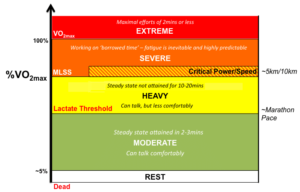
When delving into the gradients of exercise intensity, categorized explicitly as moderate, heavy, and severe, dissecting the distinctive physiological ramifications is imperative. The anaerobic threshold, a pivotal tenet within exercise physiology, delineates the shift from aerobic to anaerobic metabolism as intensity escalates. Moderate exercise typically resides beneath this threshold, whereas heavy and severe intensities intricately involve various anaerobic pathways (Furrer et al., 2023). The anaerobic threshold, frequently linked to lactate accrual, signifies a critical juncture where oxygen consumption encounters challenges in meeting escalating energy requisites. The intricate interplay among oxygen consumption, lactate dynamics, and the anaerobic threshold unveils the intricate metabolic intricacies that underpin exercise, providing insights into the mechanisms governing performance and fatigue.
Moderate-intensity exercise occurs within a range where the aerobic system adequately meets energy demands. Typically expressed as a percentage of an individual’s aerobic capacity (VO2 max), moderate-intensity exercise does not heavily rely on the anaerobic threshold (Kenney et al., 2021). Aerobic metabolism efficiently provides the necessary energy without engaging anaerobic pathways (Poole et al., 2016). With increased exercise intensity in the heavy domain, reliance on anaerobic metabolism becomes more pronounced. Oxygen consumption is vital while the anaerobic threshold is approached but not surpassed. The body efficiently clears lactate during heavy-intensity exercise, sustaining the effort for a moderate duration before fatigue ensues due to heightened contribution from anaerobic metabolism.
During intense exercise, like really tough workouts that push an individual hard, the body goes into overdrive, trying to keep up with the energy it needs. This struggle leads to lactate buildup, showing how the anaerobic system, especially the lactic acid part, becomes a significant player in making energy (Kenney et al., 2021). How well the body gets rid of this lactate is a significant factor in deciding how tired a person gets during these intense workouts. The highlights show how human bodies deal with the challenges of high-intensity exercise, showing that it is not just about one thing but a combination of changes that affect people’s performance and endurance. Finding ways to better clear lactate might help them handle super tough workouts.
The anaerobic threshold strongly correlates with a notable increase in oxygen consumption. Once this threshold is exceeded, there is a nonlinear elevation in VO2, indicating a heightened reliance on anaerobic metabolism. The ability to endure exercise at different intensities is intricately tied to the individual’s aerobic capacity, highlighting the significance of effectively utilizing oxygen to meet energy demands (Kenney et al., 2021). A more in-depth examination of these processes reveals the pivotal role of an individual’s aerobic fitness in determining their ability to navigate the transition towards anaerobic pathways as exercise intensity rises (Laursen & Buchheit, 2019). Moreover, optimizing aerobic capacity is a central focus in enhancing overall endurance and performance across various physical activities. Lactate, generated as a byproduct of anaerobic glycolysis, accumulates as exercise intensity surpasses the anaerobic threshold. Contrary to previous beliefs, lactate is recognized as a waste product and a valuable energy substrate. The lactate production and clearance rate significantly influence exercise performance, with severe-intensity exercise contributing to a surplus of lactate production and fatigue.
The anaerobic threshold signifies a pivotal juncture in exercise intensity, delineating the transition from predominantly aerobic to anaerobic metabolism. The moderate, heavy, and severe intensity domains delineate the continuum of reliance on aerobic and anaerobic energy systems, with oxygen consumption and lactate crucially influencing exercise sustainability and performance. A comprehensive understanding of these concepts is imperative for optimizing training strategies and enhancing athletic prowess.
References:
Furrer, R., Hawley, J. A., & Handschin, C. (2023). The molecular athlete: exercise physiology from mechanisms to medals. Physiological Reviews.
Kenney, W. L., Wilmore, J. H., & Costill, D. L. (2021). Physiology of sport and exercise. Human kinetics.
Laursen, P., & Buchheit, M. (2019). Science and application of high-intensity interval training. Human Kinetics.
Poole, D. C., Burnley, M., Vanhatalo, A., Rossiter, H. B., & Jones, A. M. (2016). Critical power: An important fatigue threshold in exercise physiology. Medicine and Science in Sports and Exercise, 48(11), 2320.


